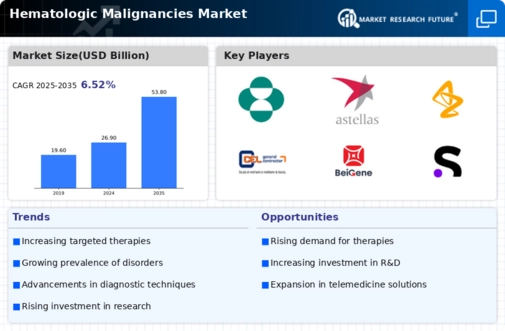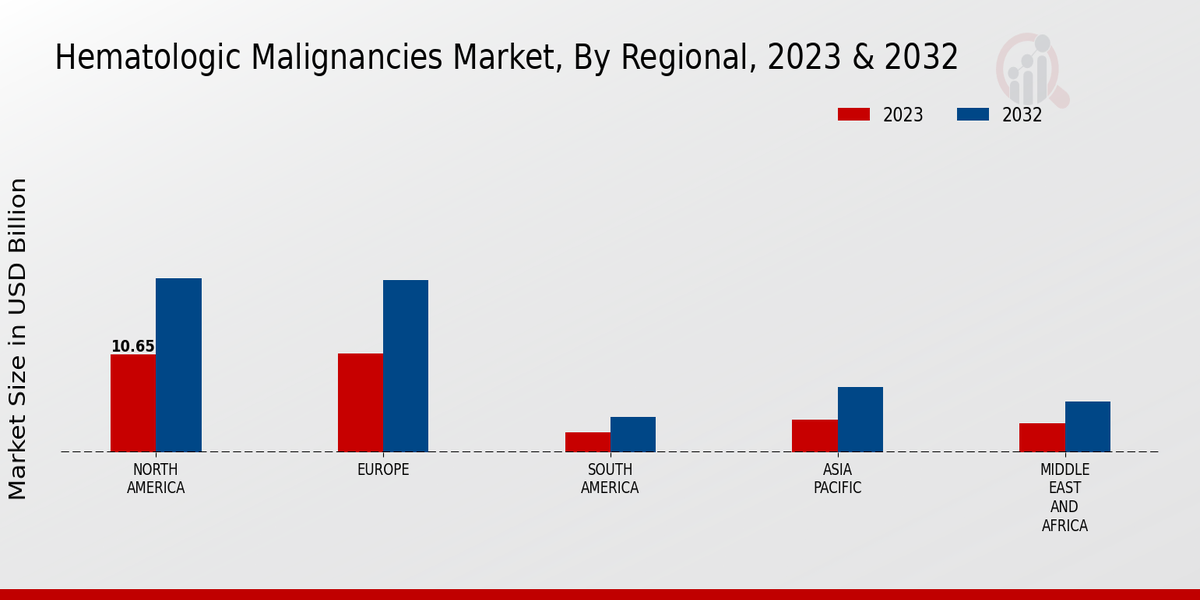Market Growth Projections
The Global Hematologic Malignancies Market Industry is poised for substantial growth, with projections indicating a market value of 26.9 USD Billion in 2024 and an anticipated increase to 53.8 USD Billion by 2035. This growth trajectory reflects a compound annual growth rate of 6.52% from 2025 to 2035. Such projections are indicative of the increasing demand for innovative therapies and the ongoing advancements in treatment modalities. The market's expansion is expected to be driven by a combination of rising incidence rates, advancements in research, and increased investment in healthcare infrastructure across various regions.
Advancements in Treatment Modalities
Innovations in treatment modalities significantly propel the Global Hematologic Malignancies Market Industry forward. The development of targeted therapies, immunotherapies, and CAR T-cell therapies has transformed the therapeutic landscape for hematologic malignancies. These advancements not only improve patient outcomes but also enhance survival rates. For example, CAR T-cell therapy has shown remarkable efficacy in treating certain types of leukemia and lymphoma. As a result, the market is expected to grow substantially, with projections indicating a value of 53.8 USD Billion by 2035. This growth underscores the importance of continued investment in research and development within the industry.
Emerging Markets and Global Expansion
The Global Hematologic Malignancies Market Industry is witnessing expansion into emerging markets, where healthcare infrastructure is improving. Countries in Asia-Pacific and Latin America are increasingly investing in healthcare systems, leading to enhanced access to diagnostics and treatments for hematologic malignancies. For example, initiatives to improve healthcare access in India and Brazil are facilitating earlier diagnosis and treatment options. This expansion is likely to contribute to the overall market growth, as these regions are projected to experience a surge in demand for hematologic cancer therapies. The industry's ability to adapt to these emerging markets will be crucial for future success.
Growing Awareness and Early Detection
Raising awareness about hematologic malignancies plays a pivotal role in the Global Hematologic Malignancies Market Industry. Increased public knowledge regarding symptoms and risk factors leads to earlier diagnosis and treatment, which can significantly improve patient outcomes. Campaigns by organizations such as the Leukemia & Lymphoma Society aim to educate the public and healthcare professionals about these diseases. As awareness grows, more individuals seek medical attention, resulting in a higher demand for diagnostic and therapeutic services. This trend is expected to further stimulate market growth as the industry adapts to the evolving landscape of patient needs.
Rising Incidence of Hematologic Malignancies
The Global Hematologic Malignancies Market Industry experiences a notable increase in the incidence of blood cancers, including leukemia, lymphoma, and myeloma. This rise is attributed to various factors, such as genetic predispositions and environmental influences. For instance, the American Cancer Society indicates that approximately 1.3 million people are diagnosed with hematologic malignancies annually worldwide. This growing patient population necessitates advanced treatment options, thereby driving market growth. As the industry adapts to these rising numbers, the market is projected to reach 26.9 USD Billion in 2024, reflecting a robust demand for innovative therapies.
Increasing Investment in Research and Development
The Global Hematologic Malignancies Market Industry benefits from heightened investment in research and development. Governments and private entities are increasingly funding initiatives aimed at understanding the underlying mechanisms of hematologic cancers and developing novel therapeutic agents. For instance, the National Institutes of Health allocates significant resources to cancer research, which fosters innovation in treatment approaches. This influx of funding is likely to accelerate the discovery of new drugs and therapies, contributing to a projected compound annual growth rate of 6.52% from 2025 to 2035. Such investments are crucial for advancing the industry and improving patient care.














